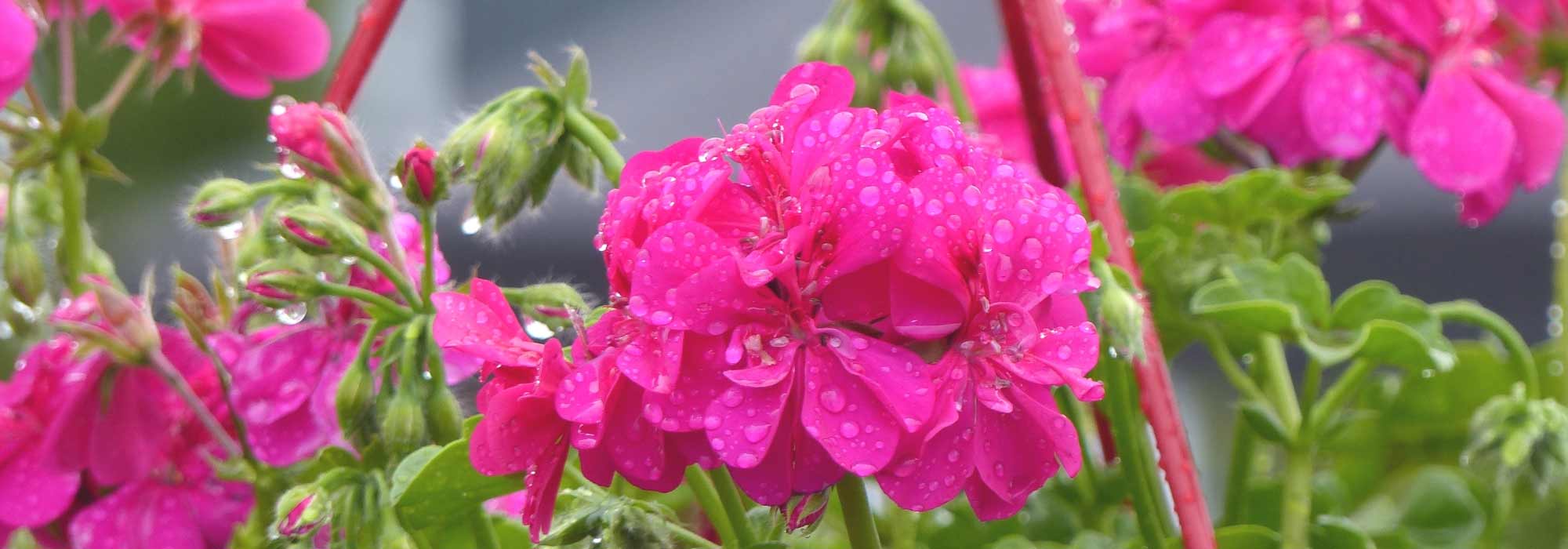
Pelargonium, geranium : planting and growing
Contents
Pélargonium in a nutshell
- Pelargonium offers long, generous flowering for much of the year, from May until first frosts
- Always beautiful and low-maintenance, geranium flowers offer a wide diversity of colours, from pastel to the most vivid
- Its foliage is sometimes variegated, often fragrant with notes of rose, lemon, apple and even chocolate, which repels mosquitoes!
- Frost-tender, it is grown as an annual in open ground or in pots and overwintered: it suits all regions
- King of balconies, hanging baskets and window boxes, it is also exceptional in beds and borders
From our expert
What would our windowsills, balconies, summer beds and borders be without Pelargonium, more commonly called geranium?
Unlike its cousin the hardy geranium, Pelargonium is a non-hardy plant, tender, generally grown as an annual unless brought indoors over winter to avoid frost. Growing it in open ground is only possible in our mildest regions.
That matters not! It offers a wide diversity of shapes, colours, textures and scents, enough to spark acute collection-itis!
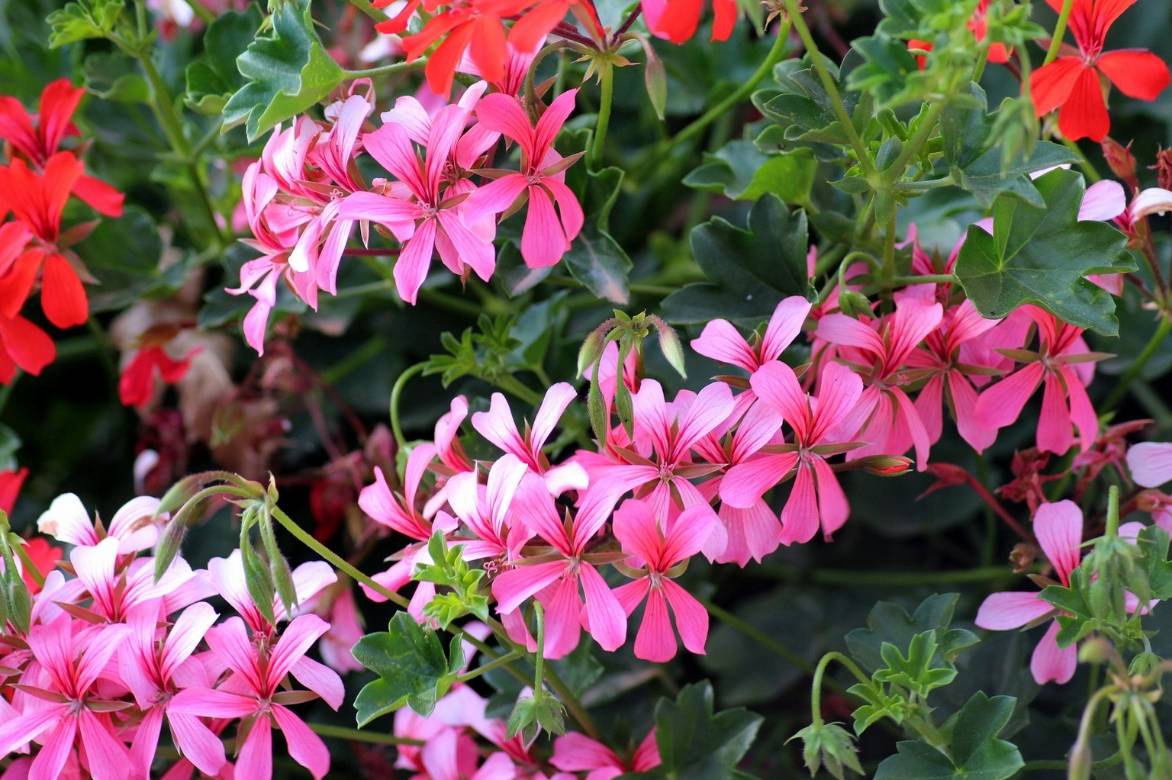
Pelargonium comes in many varieties such as Pelargonium zonale with velvety leaves marked by a darker zone, the ivy geranium (Pelargonium peltatum) “king of balconies”, which forms flowering cascades all summer, the florist’s pelargonium with large flowers or the scented pelargonium such as geranium rosat (Pelargonium graveolens) whose foliage, rich in essential oils, gives off varied fragrances of rose, lemon, mint or even chocolate depending on cultivar, and is said to repel mosquitoes.
If leaves of scented pelargonium are edible, its root is also used in herbal medicine for its cleansing benefits.
It boasts a long, generous flowering period of six months of year (or longer if kept warm over winter), ranging from pure white to the most dazzling red, until first autumn frosts bring it to a halt.
Sometimes elegant, sometimes almost gaudy, it thrives in all gardens whatever their style: in beds, borders, rockeries, containers and hanging baskets.
Always beautiful whatever the weather, geranium flowers need only sun and some regular watering.
From care to pruning, discover our advice and fall for our exceptional collection of pelargoniums in mini plugs or for our geranium seeds so easy to sow! So why resist?
Description and botany
Botanical data
- Latin name Pelargonium
- Family Geraniaceae
- Common name Pelargonium, Scented geranium, Florist's geranium, Balcony geranium
- Flowering from April-May until autumn
- Height 0.15 to 1 m
- Exposure sun or partial shade
- Soil type all, well-drained
- Hardiness frost-tender
Pelargonium, better known as geranium, is a perennial or an undershrub belonging to family Geraniaceae.
Originating from mountain areas of South Africa, Pelargonium is not hardy in our climates where it is generally grown as an annual on terraces or balconies, unlike its cousin the hardy geranium which is a hardy species able to remain in ground in our gardens. Pelargonium is in fact often wrongly called “geranium”. Geraniums and Pelargoniums are two distinct species, although they belong to same family. However, use of name “geranium” for pelargoniums has remained common.
Genus Pelargonium includes about 230 species and nearly 1,000 varieties. Many cultivars and hybrids have been produced from some twenty species including Pelargonium grandiflorum, the florist’s pelargonium (Pelargonium x domesticum), Pelargonium graveolens or the rose-scented geranium, the most fragrant of all used in perfumery, origin of many hybrids, Pelargonium fragrans with a pine scent, Pelargonium crispum, Pelargonium peltatum or ivy geranium, nicknamed “King of Balconies” for its trailing habit.
Today very few botanical pelargoniums remain owing to extensive hybridisation. Most cultivars fall into four main groups: ivy pelargoniums with very trailing stems much appreciated in hanging baskets and window boxes, zonal pelargoniums (Pelargonium x Hortorum) of the classic upright habit much used in bedding, Regals or large-flowered pelargoniums and scented pelargoniums or rose-scented geraniums, also called “scented geraniums”, whose leaves are aromatic.
There are also “Unique” pelargoniums which are undershrubs that can reach 1 m in height in a single season and whose foliage emits a strong spicy, pungent scent at the slightest touch.
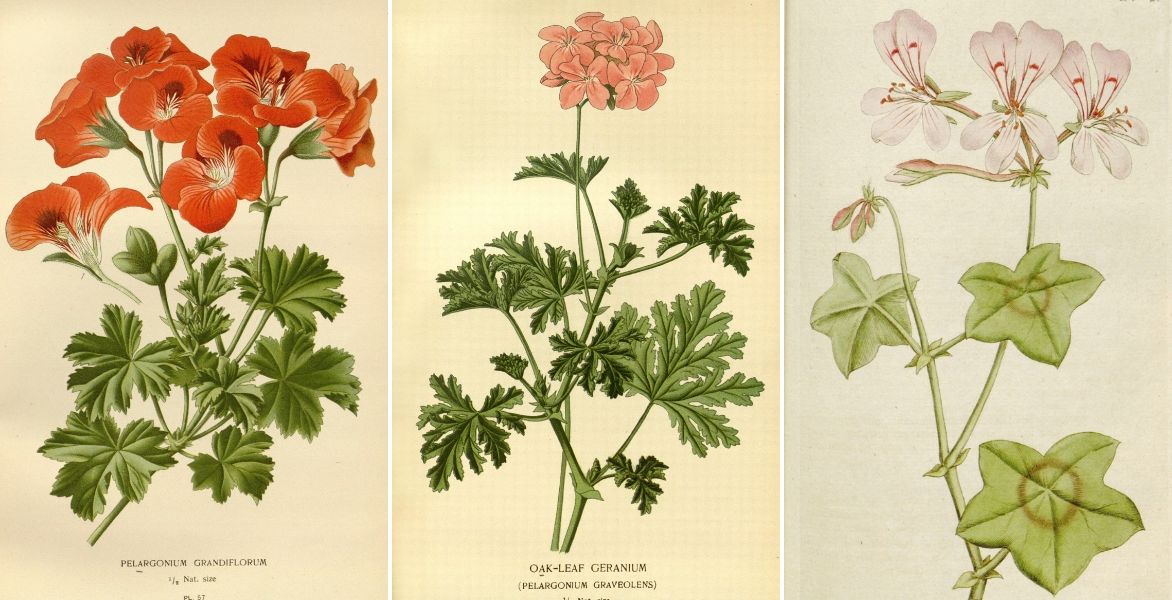
Botanical illustrations: Pelargonium grandiflorum / Pelargonium graveolens / Pelargonium peltatum
With a rapid growth, the plant forms a dense, bushy clump, almost as wide as tall, with development varying from 0.10 cm in height for dwarf and miniature varieties to 1.20 m for the largest pelargoniums. Some geraniums resemble a small bush with a spreading habit.
Habit varies by variety, erect in zonal geraniums which form a compact or very spreading bush and trailing in the famous ivy geranium. Its stems can reach 1 m in length.
Branched stems carry leaves that also take various shapes: alternate, fleshy, rounded, lobed or pointed, deeply veined, velvety or glossy, with dentate or undulate margins. Leaves are mostly evergreen in regions spared from winter frosts.
They are leathery, smooth and shiny, similar to ivy leaves in ivy pelargoniums, rounded like fans, funnel-shaped in Pelargonium cucullatum and sometimes so lobed they resemble maple leaves.
They often have a long petiole, measure from 1 to 15 cm in diameter and display all shades of green; bright green in ivies, mid green, pale green sometimes variegated with cream-white, gold or silver, or green-grey edged with red. They can be bicoloured or tricoloured. There are many varieties with decorative foliage such as ‘Mrs Pollock‘, ‘Vancouver’ popular with collectors.
The zonal geranium (notably cultivars like ‘Fantaisie’) is distinguished by its round, often zoned leaves (hence “zonal”), sometimes attractively marginated with a lighter tone and especially marked by coloured halos arranged in irregular concentric rings of brown, dark bronze-green, slate-blue or black or in “butterfly wings”, with a clearly distinct tone at centre of leaf.
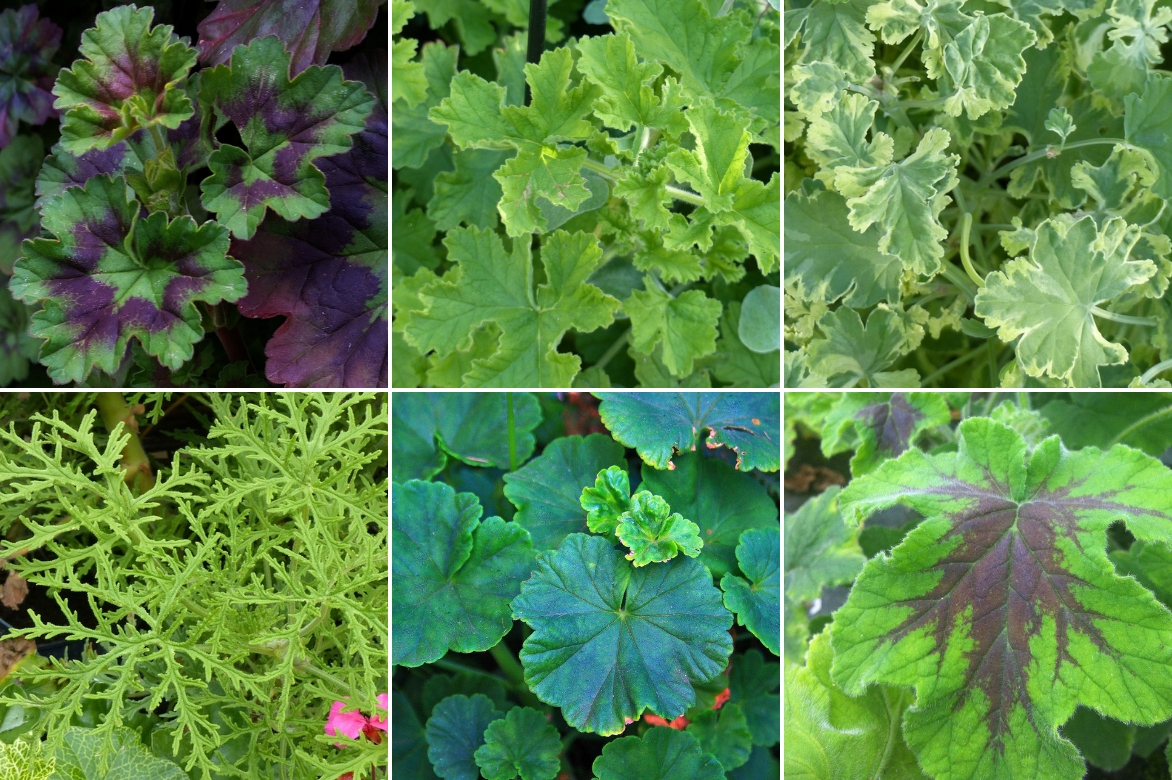
Diversity of foliage in pelargoniums
Foliage of the scented pelargonium, rich in essential oils, is strongly aromatic: its leaves, rougher or softer, plicate, often deeply incised, release very varied scents at the slightest crush such as lemon-rose, green apple, lemon, citronella, orange, mint, eucalyptus, pine in Pelargonium fragrans, spices and even hazelnut, chocolate or carrot! Pelargonium x graveolens and rose-scented pelargonium (P. capitatum), with rose fragrance, are highly prized in perfumery.
This aromatic foliage is said to repel mosquitoes.
Its edible leaves are also used to flavour fruit salads.
Overwhelming the foliage, flowering—often particularly long and abundant—occurs from April to October depending on species or year-round for plants kept between 10 and 15°C. Pelargonium produces masses of single, semi-double or double flowers attractive both in bud and when fully open.
At stem tips, flowers grouped in terminal umbel-shaped clusters of varying size are renewed throughout summer, contrasting nicely with foliage.
Their shape varies by species: zonal pelargoniums bear large flower heads single or double gathered into impressive spherical clusters 5 to 13 cm in diameter that stand out from foliage, while ivy and scented geraniums produce countless smaller flowers gathered in looser, less imposing umbels. Flowering of aromatic-leaved pelargoniums, less spectacular, is more discreet and delicate.
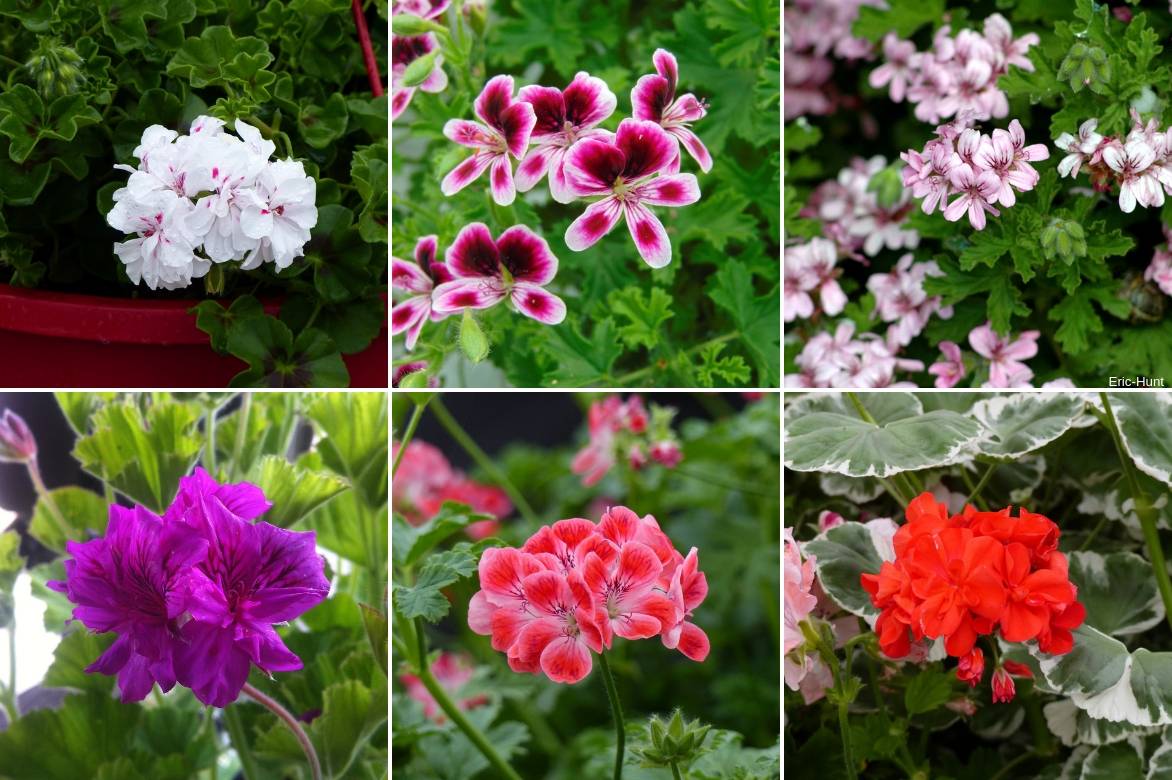
Some flowers: Pelargonium peltatum ‘Big 5 White Angel’, Pelargonium ‘Mosquitaway Eva’, Pelargonium graveolens, Pelargonium cucullatum, Pelargonium ‘Paton’s Unique’ and Pelargonium ‘Wilhelm Langguth’
Flowers, made up of at least 5 to 6 petals, are cup-shaped, star-shaped, trumpet-shaped, funnel-shaped or butterfly-shaped (the two upper petals being larger than the three lower petals) and measure from 1 to 4 cm in diameter. Some are like small roses (Pelargonium hortorum ‘Appleblossom’) or even resemble dahlia-cactus flowers with twisted, rolled petals, or consist of narrow, pointed petals with cut edges (Fireworks ‘Scarlet’).
Summer flowering is variable in colour and not limited to traditional fire-engine red; it ranges by variety from solid to multicoloured, vivid, rare, deep or pastel shades from wine-bordeaux, fresh pink, mauve, purple, pure white, more rarely yellow to salmon-orange. These bright or velvety colours do not fade under strong sun.
Some petals are veined, streaked with subtle bicoloured or sometimes tricoloured shades, showing small macules of varying contrast.
After flowering, flowers give way to fruits whose very elongated shape resembles a bird’s beak—hence name “pelargonium”, from Greek meaning “stork”.
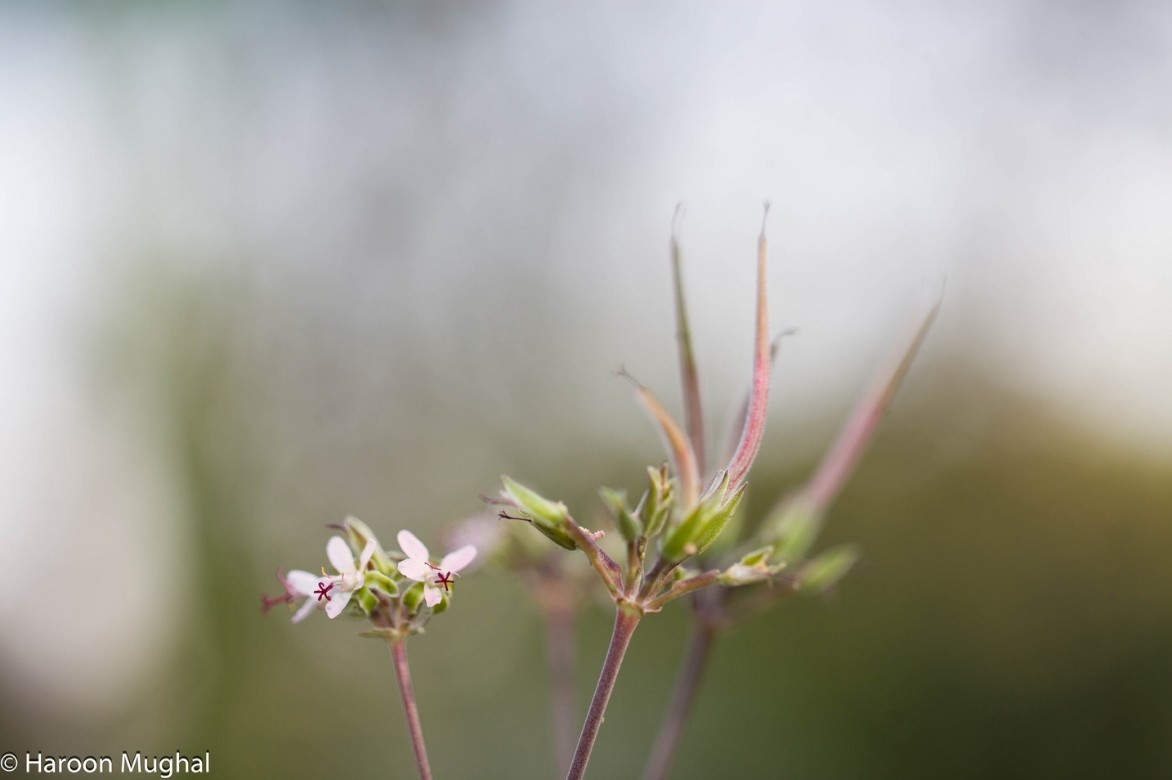
Typical beak-shaped fruits
Flower of the scented pelargonium, lightly perfumed, is edible and can garnish summer desserts such as sorbets.
Not hardy, pelargonium is somewhat tender and should be taken into greenhouse or indoors in regions with cold winters. Drought-tolerant, it grows quickly in light, well-drained fertile soils, in full sun or preferably in partial shade in hot regions.
Geranium is the must-have annual plant for summer displays, to bring structure and colour to beds, flower borders and sunny edges, as well as in hanging baskets and window boxes on terrace, balcony or conservatory.
For centuries, pelargonium root has been used in herbal medicine for its benefits and its purifying medicinal properties against symptoms of respiratory infections such as bronchitis.
Main species and varieties
Not always easy to find one’s way among 230 species of pelargoniums! First distinguish the Pelargonium, which is frost-tender and grown at our latitudes as an annual, from the Hardy geranium, which is hardy and can remain in ground for years in garden.
Pelargonium is wrongly called “geranium”. It was botanist Carl Von Linne who in 1787 grouped under same genus Pelargoniums and Geraniums. About 25 years later, French botanist L’Héritier realised the mistake and created genus Pelargonium. Too late! Error persisted for a long time… Both plants do belong to same family, Geraniaceae, but that is their only point in common!
Several groups of pelargoniums can be distinguished, within which many cultivars have been created. Not to mention the hybrids! They suit every use and come in a multitude of colours, and offer great diversity of textures and scents!
- Pelargonium zonale (30 to 50 cm high): This is the classic geranium, forming colourful clumps with its upright stems, its beautiful round, velvety leaves marked with a contrasting halo and its large flower heads in every shade of red, pink and white, plain or bicoloured. It belongs to the large group of hybrids Pelargonium x hortorum. Used in borders and window boxes.
- ivy pelargonium (up to 1 m high): Known as the “king of balconies”, most used in pots, in window boxes or hanging baskets. It forms cascades of trailing or creeping flowers. Its bright, glossy leaves recall ivy.
- Scented-leaved Pelargonium: Flowering is more discreet, its foliage rough or velvety and sometimes variegated with yellow or silver, and above all it exudes a range of scents of apple, mint, spice, lemon or orange when crushed. P. x graveolens and P. capitatum give a rose scent, widely used in perfumery.
- florist’s pelargonium or large-flowered pelargonium (Pelargonium grandiflorum): Also known as pelargonium “Regals”. It resembles zonal pelargonium but has dentate leaves and much larger inflorescences. Often grown indoors or in a greenhouse.
Discover our unique collection of geraniums as plug plants or as seeds, including some exclusive varieties!
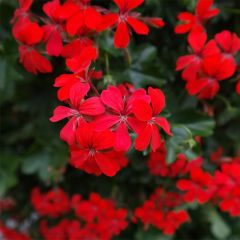
Pelargonium peltatum Balcon Imperial Red
- Flowering time June to December
- Height at maturity 20 cm

Pelargonium Brocade Mrs Pollock
- Flowering time June to November
- Height at maturity 45 cm
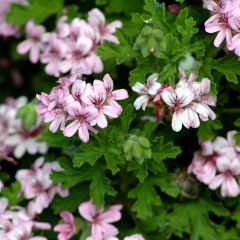
Pelargonium graveolens
- Flowering time July to October
- Height at maturity 60 cm
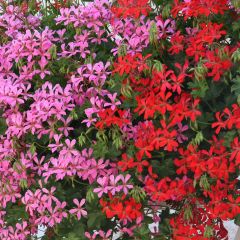
Collection of 10 Red and Pink Balcony Geraniums
- Flowering time August to December
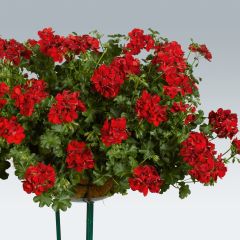
Pelargonium peltatum Ruby
- Flowering time July to December
- Height at maturity 50 cm
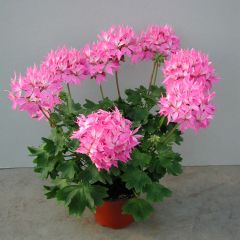
Pelargonium hortorum Fireworks Pink
- Flowering time June to November
- Height at maturity 40 cm
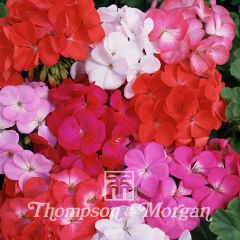
Pelargonium Border Supreme F2 Seeds - Geranium
- Flowering time August to November
- Height at maturity 35 cm
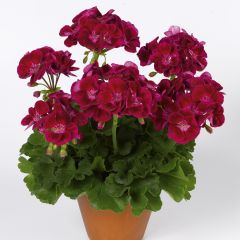
Pelargonium hortorum Flower Fairy Velvet
- Flowering time June to November
- Height at maturity 35 cm
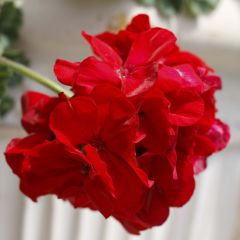
Pelargonium Cassiopeia
- Flowering time June to November
- Height at maturity 50 cm
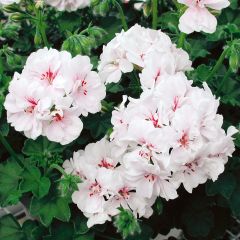
Pelargonium Blanche Roche - Ivy Geranium
- Flowering time June to December
- Height at maturity 20 cm
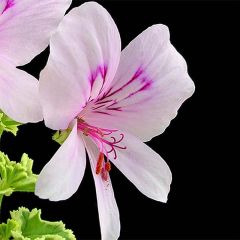
Pelargonium crispum Variegatum
- Flowering time July to October
- Height at maturity 80 cm
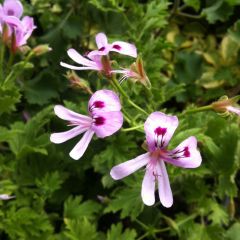
Pelargonium Lemon fancy
- Flowering time July to October
- Height at maturity 60 cm
Discover other Pelargonium - Geranium
View all →Available in 1 sizes
Available in 1 sizes
Available in 1 sizes
Available in 1 sizes
Available in 1 sizes
Available in 1 sizes
Available in 1 sizes
Available in 2 sizes
Available in 2 sizes
Available in 1 sizes
Planting
Where to plant a pelargonium or geranium?
Pelargonium is a plant native to South Africa, sensitive to frost and consequently somewhat tender in our climates. Below 0°C, pelargonium will not survive.
If it can remain in ground in mild coastal climate and in areas spared from severe frosts, keeping its foliage even in winter, it will simply need to be overwintered in an unheated greenhouse or conservatory at a minimum temperature of 10°C elsewhere or grown as an annual. You can therefore keep it from one year to the next by protecting it from frost over winter and bringing pots back outside in the growing season.
Note that Elisabeth, our Mediterranean climate specialist, grows a Pelargonium quercifolium in ground. It has been there for five or six years, reaches over 1 metre in height and reshoots readily from the stump when it has frozen a little. Finally, she never waters it!
Accommodating regarding soil, naturally resistant to summer drought, unfazed by bad weather, if satisfied with a good well-drained soil it performs best in a rich, light soil.
From its South African origins, it has retained a love of sun and heat. It thrives in full sun or partial shade in southern France.
You can plant your pelargonium in ground or in a pot.
With decorative, sometimes scented foliage and such generous flowering, Pelargonium is a must in romantic, colourful or chic summer displays. It is ideal for naturalistic gardens.
Not hardy, it is the star annual of summer displays with ephemeral charm, to be replanted each year according to taste. Long confined to hanging baskets and window boxes on windowsills, balconies and terraces, pelargonium now takes its place in borders, beds and sunny edging where it quickly brings a very cheerful, colourful touch throughout the season.
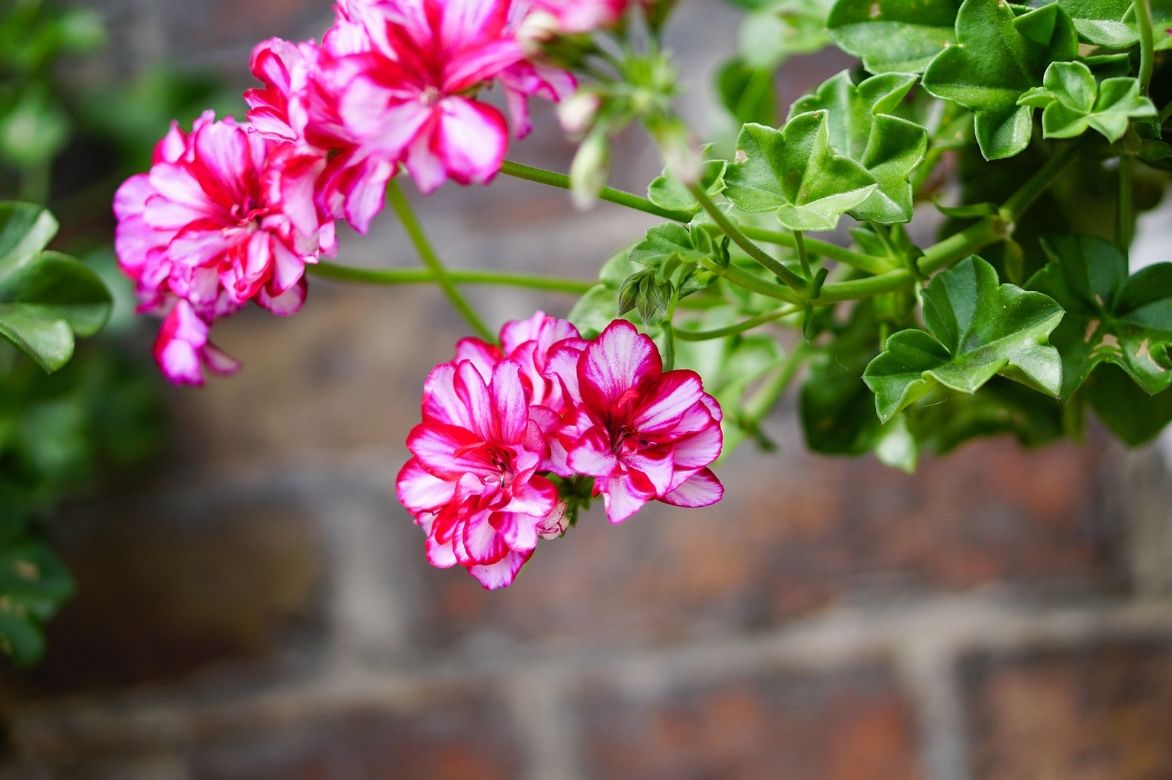
Ivy geraniums with a trailing habit form flowering cascades ideal for hanging baskets and rockeries and are excellent as groundcover. They can also be trained on a trellis against a wall outdoors or in a winter garden.
Zonal geranium grows in colourful compact clumps and will be perfect in beds, pots and borders.
Scented geraniums are wonderful as a low hedge or border along a path or in a on the terrace or in the conservatory, never too far from the house to enjoy their scent.
Finally, all are well suited to greenhouse cultivation.
When to plant a pelargonium or geranium?
Planting of pelargonium or geranium is done in spring but timing varies by region. In mild-climate regions you can plant our pelargoniums as plug plants from March–April. Wait until mid-May in the northernmost regions to plant out. Meanwhile you can pre-cultivate them in pots in a warm, bright spot to speed their growth.
In all cases, on receipt prick out and store under cover (conservatory, greenhouse…) at a temperature above 14°C and wait until frost risk is gone and soil is well warmed before planting or moving outside.
How to plant a pelargonium?
- In ground
For a bold, colourful massed effect, favour group planting. Allow 5 to 7 young plants per m² and space them 20 cm apart. It needs a light, humus-bearing but especially free-draining soil. Add gravel where water tends to stagnate.
- Fork over soil well
- Dig a hole two to three times the size of the plug plant
- Position the plug plant and cover without burying it too deeply, adding a little leaf mould
- Firm gently without damaging the young plant
- Water well at the base
More advice on planting annuals from plug plants on our blog!
- Planting geraniums in pots or window boxes
All geraniums are kings of hanging baskets, window boxes, urns or pots, but ivy geraniums are the most used. Use a well-draining compost to avoid stagnant moisture at the roots. Feel free to mix varieties for sparkling floriferous combinations!
- In the base of a drained container, lay a good drainage layer (gravel, broken pottery or clay balls)
- Plant in a compost such as “geranium” mix or in loam mixed with compost
- Place in sun
- Water regularly, never letting the substrate dry out between waterings: compost should always remain moist but never waterlogged
- Bring potted pelargonium out after frosts
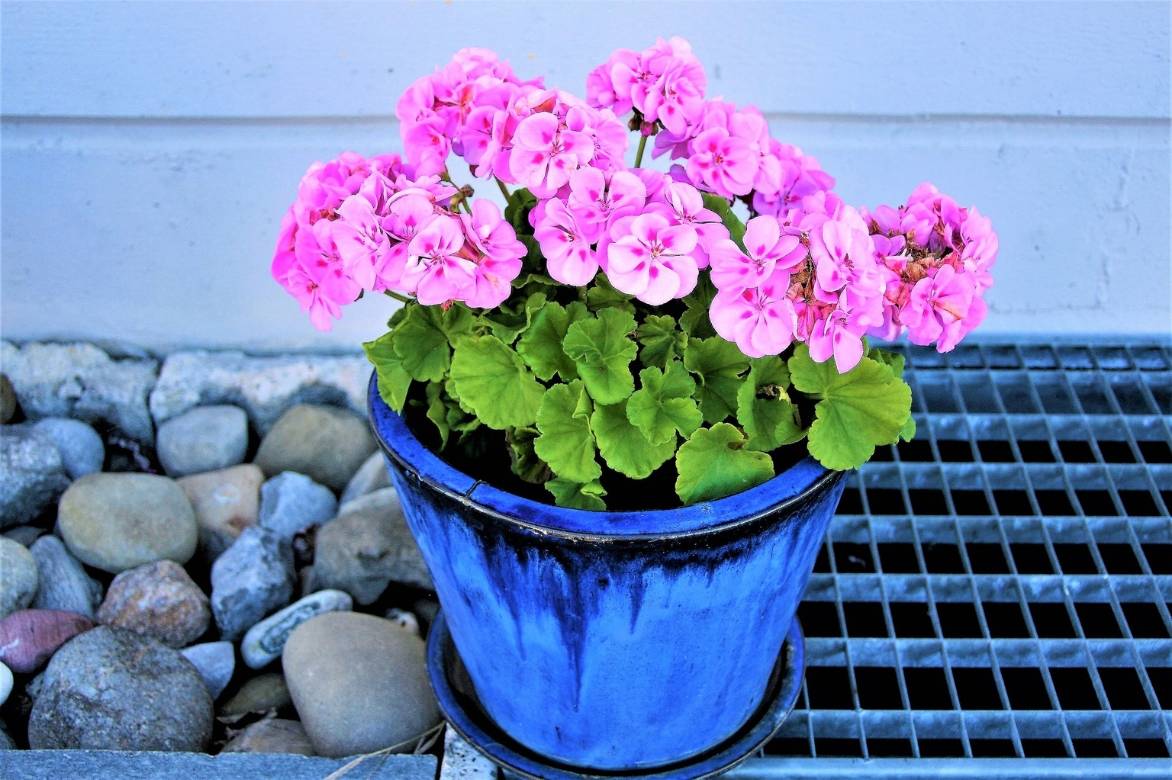
When and how to sow Pelargoniums or geraniums?
Sowing of pelargonium seeds is carried out under cover from mid-January to mid-March. Young plants should be transplanted outdoors into open ground once risk of frost has passed. They will flower in year of sowing.
How to successfully sow geranium seeds?
- Sow geranium seeds 2 cm apart, surface-sown (not buried) in a seed tray filled with a sowing compost
- Cover with 1–2 mm of compost
- Keep in warmth at minimum 18°C, ideally 20–25°C
- Keep compost moist but not waterlogged
- Germination occurs in 10–15 days
- When at four-leaf stage, transplant young plants into individual pots or buckets
- In mid-May, after all risk of frost has passed, transplant outdoors into ground, pots or planters
- Pinch out tips of stems of young rooted cuttings fairly early to encourage their branching
Discover our tips to successfully sow annual seeds! and our advice sheet on the propagation by cuttings of Pelargonium
Maintenance, pruning and care
Pelargonium is a very floriferous annual plant that grows without requiring much care.
In open ground, it tolerates lack of water fairly well: water only during first weeks following planting.
Potted geraniums must be watered one to three times a week but without excess, as soon as soil surface dries out: substrate must remain moist.
Potted geranium is a heavy feeder, requiring weekly applications of liquid “geranium” fertiliser from April to August to promote continuity of growth and flowering.
Remove all first flower buds and pinch out the tip of young plants to encourage their branching.
Remove faded flowers regularly and yellowing foliage to encourage appearance of new flowers and lengthen flowering period.
Pelargoniums do not tolerate frost. In autumn, lift plants grown in open ground, discard them or temporarily replant them in pots of same size or slightly smaller.
Bring pots indoors to a cool but bright, frost-free place to keep them from one year to the next.
→ Find out more about Pelargonium care in winter in our tutorial!

How to keep geraniums over winter?
Pelargoniums or geraniums can continue to flower all winter if kept between 7 and 10°C in a bright room. For all you need to know about their overwintering, see our advice sheet: Successful overwintering of Pelargoniums (balcony geraniums)
Diseases and potential pests
Pelargonium is susceptible to certain diseases and pests.
Cold and excess water can cause grey rot (Botrytis) of the roots and of the base of the stems (blackleg). Pelargonium zonales are susceptible to rust. In both cases, burn affected leaves and treat if there is still time with Bordeaux mixture.
Against whiteflies (aleurodes), hose the foliage and keep slugs away naturally with our advice.
Its stems can also be prey to the green caterpillar of a small brown moth called “geranium bronze”, which can rapidly kill the plant. Cut all affected stems.
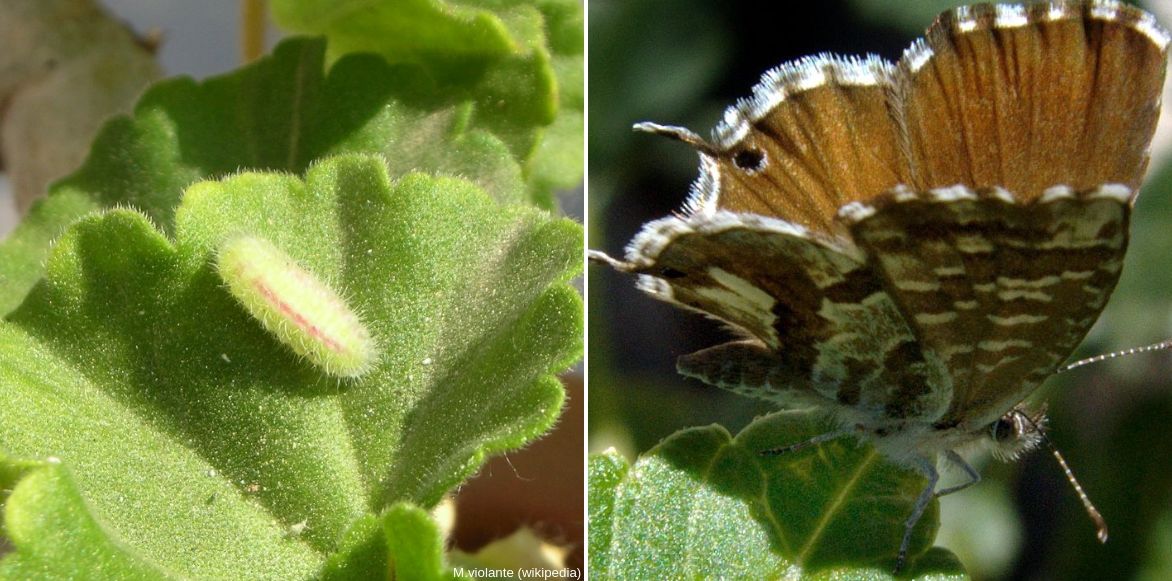
Caterpillar and moth of the geranium bronze (Cacyreus marshalli)
Beware also of aphids which can invade it: hose plants with soapy water to dislodge them.
More details in our article: Diseases and parasitic pests of pelargoniums.
Propagation
Pelargonium or geranium is easily propagated by propagation by cuttings. Cuttings taken in late summer will flower as early as the following spring.
When and how to take a cutting from geranium?
In July–August, choose a healthy pelargonium and take several cuttings.
- Cut a non-flowering stem about 10 cm long with pruning shear, just below a node
- Remove all lower leaves, leaving only two upper leaves
- Cut the base at an angle and make a small incision with a sharp knife
- Place in a perforated tray (you can also prick the cuttings into individual buckets) containing a mixture of turf and sand, inserting the cuttings halfway into the medium and spacing them 10 cm apart
- Water thoroughly
- Close the container with a lid or a plastic bag
- Keep moist throughout winter, dry and in full light in a room heated to 12–15°C
- At the end of winter, pot them into individual buckets
- Plant out in ground or move pots outdoors around mid‑May
→ Read also : How to propagate pelargonium or balcony geraniums?
Pairing pelargoniums
With their bright or pastel colours, Pelargoniums or geraniums adapt to every desire, in ground or in pots to create often very colourful and cheerful displays throughout the summer season.
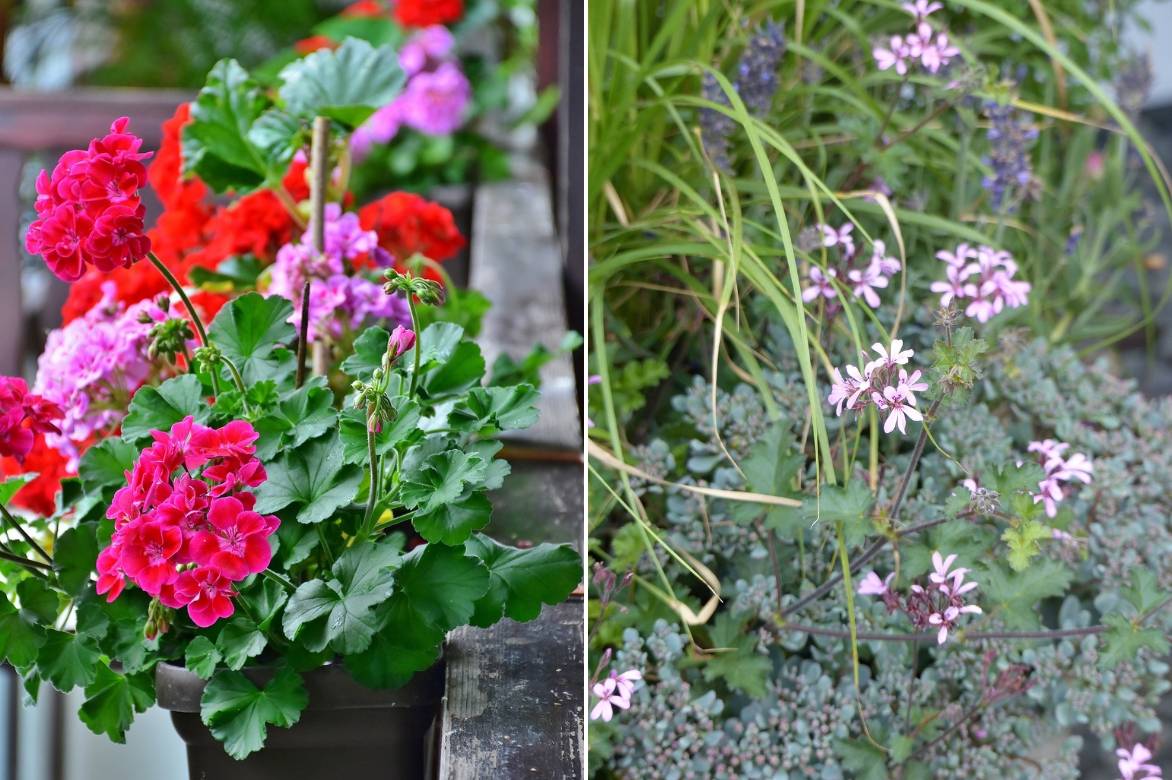
Examples of uses: in window boxes in bright colours or in beds with pastel tones with Liriope muscari ‘Ingwersen’ or grasses such as Carex and low spreading Sedums such as ‘Cape Blanco’, ‘Purpureum’, ‘Album Superbum’, sieboldii, etc
They come in an infinite range of colours allowing endless combinations, in gradients or monochrome, elegant and chic or sparkling! They adapt to all garden styles, from romantic to naturalistic.
They pair well with many summer flowers, annuals or perennials.
In a refined summer border, combine zonal geraniums with white or pearly-pink flowers with purple ageratums, Buenos-Aires verbenas and dense clumps of small mealy salvias.
In a multicoloured bed, mix geraniums with dwarf dahlias and marigolds (they will help protect them from whiteflies).
They also combine very well with plants of a lighter silhouette, such as Cleomes, Nepetas, nicotianas and cosmos.
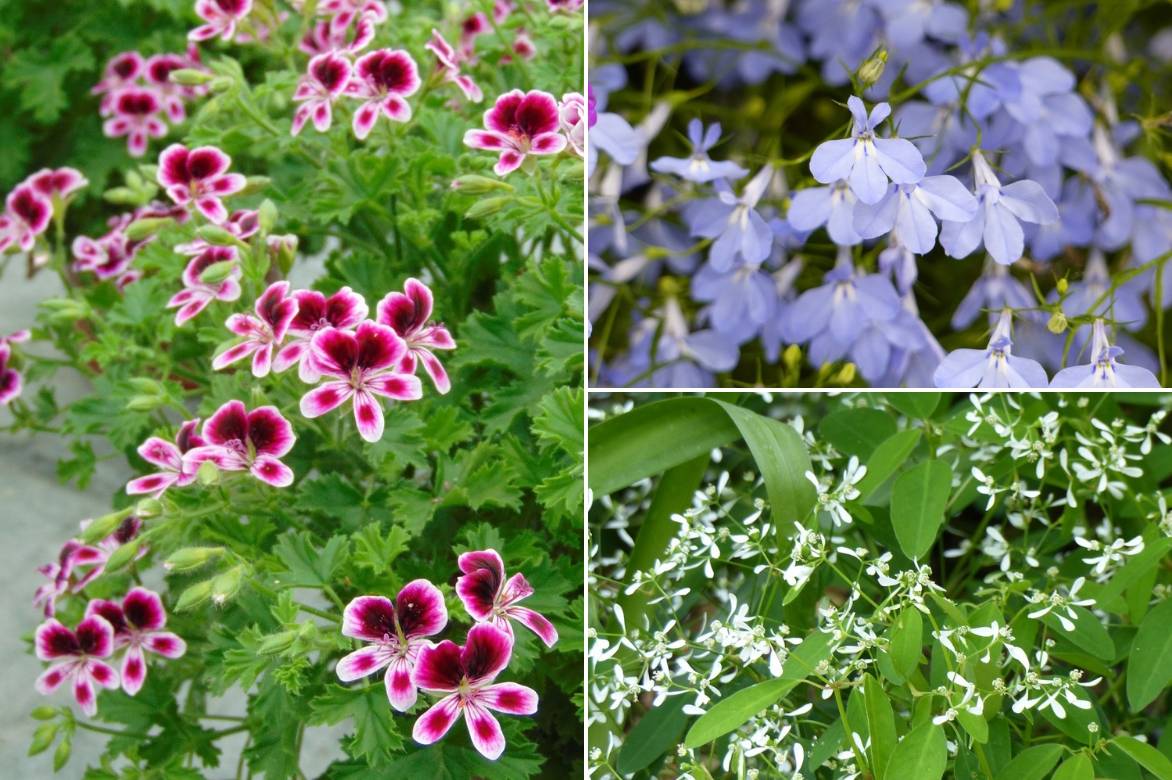
An idea for a combination: Pelargonium ‘Mosquitaway Eva’, Lobelia ‘Hot Water Blue’ and Chamaesyce hypericifolia ‘Diamond Frost’
Paired with petunias, ivy geraniums will hide the bare base of a bush rose throughout the summer season.
At the edge of a colourful summer bed, pelargonium flowers combine nicely with the contrasting blooms of zinnias and rudbeckias, and with the pointed silhouettes of phormiums and cordylines.
The intense colour of scarlet geraniums pairs well with bronze or purple foliage of heucheras, castor oil plant, dahlias and large cannas.
You can also intersperse them to punctuate borders of grey-foliaged plants such as cerastiums, Helichrysum, dusty miller or Artemisias.
Ivy geraniums can be trained against a conservatory wall, alongside other climbing annuals such as morning glories and ipomoeas.
Create magnificent pots and hanging baskets by combining them with Calibrachoa ‘Million Bells’, Bacopa, lobelias or scaevolas.
Useful resources
- Discover our scented geraniums: their foliage exudes scents of rose, lemon, mint, spices and even carrot, enough to rout a squadron of mosquitoes!
- Whether ivy-leaved, zonal or scented, Geraniums or Pelargonium are generous plants, stars of our gardens, terraces and balconies in summer, so don’t miss out!
- With their romantic or very vivid colours, they are essential for composing “Happy” scenes throughout summer, and feature in a pink garden, in a Catalan-inspired setting or simply in a white garden!
- Find our tips to choose an ivy-leaved geranium, king of flower-filled balconies all summer long.
- Discover our 7 ideas to create beautiful summer planters
- Read our article: 10 pelargoniums with scented foliage
- Discover our tutorial: How to prune a Pelargonium?
Frequently asked questions
-
Why are the leaves on my geraniums turning yellow?
Not too much, not too little! That's what to remember when watering geraniums. If water is lacking, leaves yellow and fall; conversely, too much water harms flowering and plant health, and roots may rot. Geraniums grow best in light, very well-drained, well-aerated, fertile soil or potting compost, whether in garden or in pot. In pots, water your pelargoniums once a week. Potted pelargoniums are quite demanding and, if short of fertiliser, foliage may also yellow. Remember to feed them throughout the growth period.
- Subscribe!
- Contents
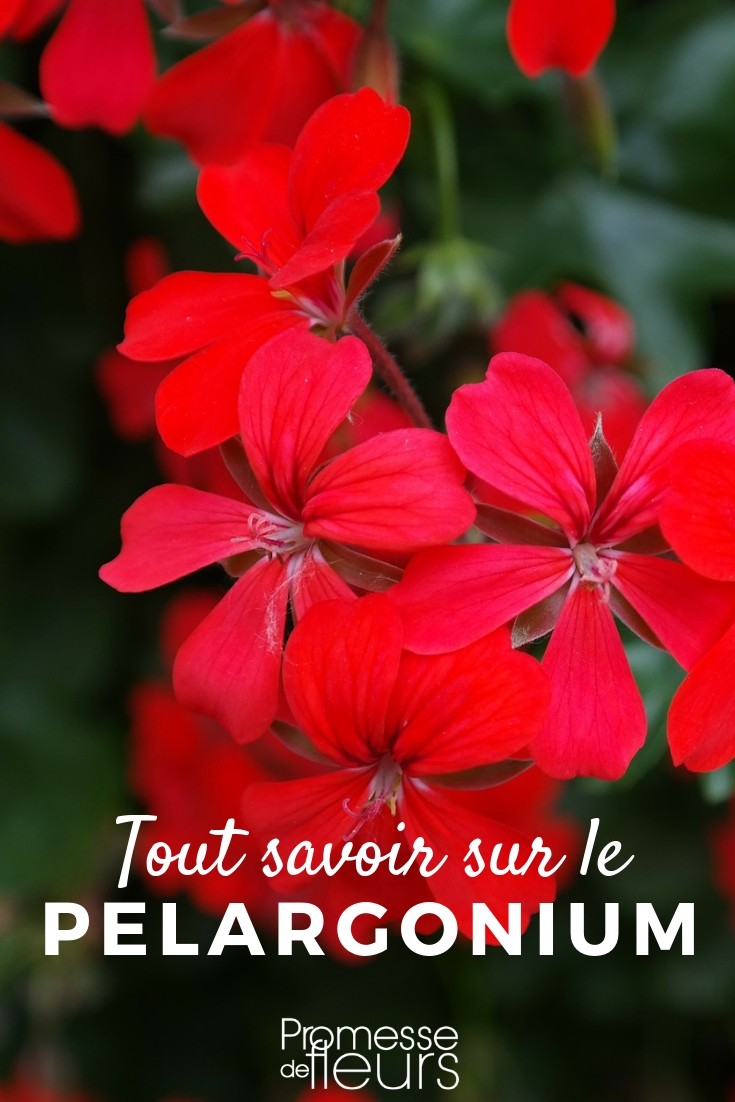

































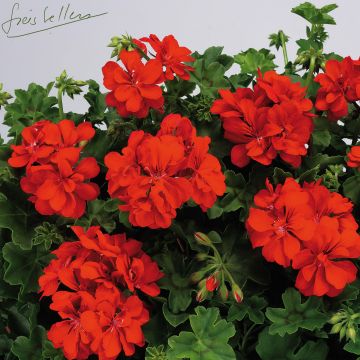
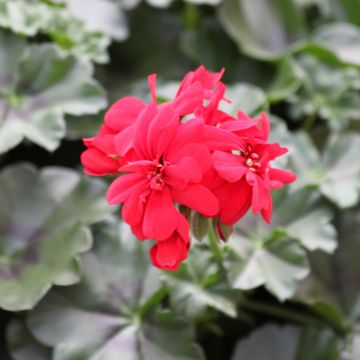
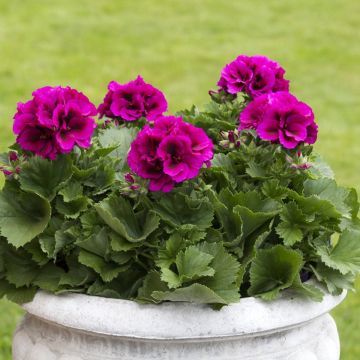
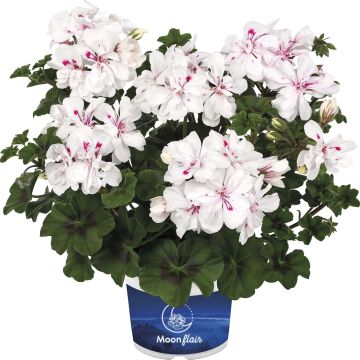
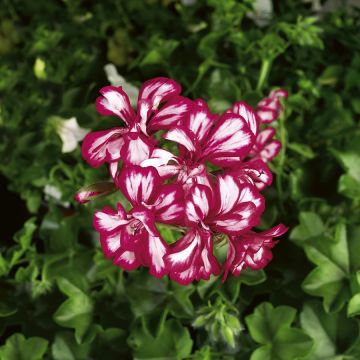

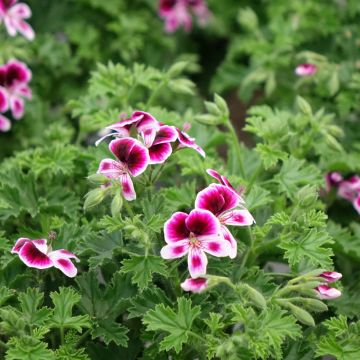
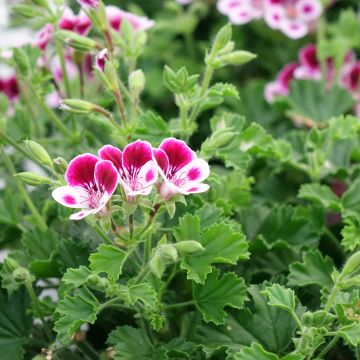
Comments